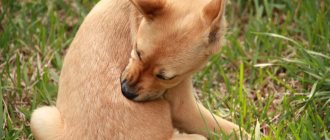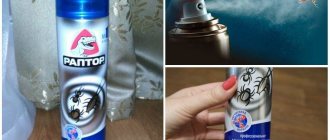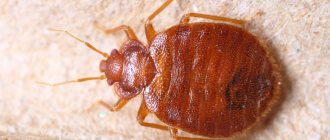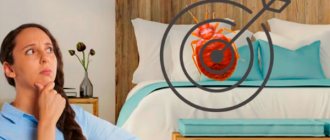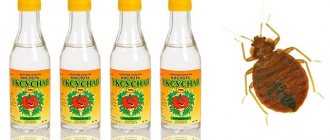Insects in kittens are a frequent occurrence and removing them takes a long time. Even if the cats are domestic, this is not a guarantee that the parasite will not cling to their coat: often the owners bring fleas on their shoes. There are products on sale that destroy parasites - drops, collars, shampoos. But most owners are rather interested not so much in the question of how to remove fleas from a kitten, but rather in how not to harm them. Flea medications for kittens are poisonous and a mistake can become critical.
Signs of fleas in a kitten
Signs that your cat has been attacked by fleas include:
- Frequent, almost constant scratching;
- Rubbing the sides or muzzle against furniture or other hard objects;
- Anxiety or, on the contrary, “sadness”;
- Poor health, sluggish appetite.
The cat’s coat will also reveal itself: scratches, bald patches, scabs from constant scratching of bites appear on it, and parasite eggs can be seen. Fleas on a kitten are visible even without a microscope; their brown elongated body cannot be confused with anything else.
What do cat fleas look like?
Cat fleas are dark brown in color and small in size. The length of their body, covered with a glossy chitinous covering, ranges from 2 to 5 mm. Characteristic features of ectoparasites:
- flattened frontal part;
- close-set black eyes;
- many bristles on the body, with the help of which their owner moves along the animal’s fur;
- oral apparatus that allows the flea to feed on blood;
- a shortened proboscis, due to which the pest feeds in an upright position, plunging part of its body into the body of the victim.
The characteristic jumping ability of insects is provided by 6 legs. The hind limbs are especially developed. The protein resilin accumulates in their muscles, thanks to which the parasite is able to cover a distance 200 times its size in one jump.
How a kitten got fleas
Even at home, you can’t be sure that kittens won’t have fleas. The main danger, and not only in terms of bloodsuckers, is the street. You can endlessly search for the answer to the question of how to get rid of fleas from a kitten; self-walking will nullify all efforts. But even if animals do not leave the house, kittens can develop ectoparasites. The risk is especially high:
- On the first floors of a private or multi-storey building, where cats often sneak into and where there are entrances to the basement, fleas come from there;
- When meeting someone else's infected cat;
- At exhibitions;
- At a party where there are other animals;
- In veterinary clinics.
A kitten can get sick, even if it has not had time to visit anywhere - domestic cats also infect their offspring.
To imagine the scale of the problem for cats, it is enough to know what kind of insects they are. A female flea lays up to two thousand eggs throughout her life. Fleas are jumping and elusive. It is enough for an adult insect, larva, or imago to be close to the kitten for infection to occur. Fleas multiply very quickly and soon the cat's coat will be infested with parasites.
Who are fleas
A flea is a very small insect that feeds on the blood of domestic animals. They have a flat body and small but tenacious paws, thanks to which they move quite quickly around the body of even long-haired cats.
These bloodsuckers are equipped with a shell, which makes it impossible to crush them, for example with your fingers. Like a number of other harmful insects, fleas belong to the category of carriers of various infections.
These are very tenacious individuals, capable of surviving without a donor for a long time without dying. As a rule, fleas are not particularly harmful to humans, but they do not bode well for kittens.
It is not always possible to immediately identify fleas in domestic kittens - they are mainly noticeable when there are already a lot of them and characteristic signs appear.
How to rid a kitten of fleas
It is more difficult to cope with the problem using folk remedies if there is more than one kitten in the house. It's not just about the risk of re-infection. The main difficulty in removing bloodsuckers is the limited possibilities of using flea control drugs. Almost all special drugs are poisonous. Usually, kittens are washed with shampoo or treated with another disinfectant from a veterinary pharmacy. Insecticides cause no less harm to cats than fleas themselves, even to adult cats. The danger for the fragile immunity of children is even higher. The question of how to remove fleas must be resolved with the participation of a veterinarian. Not only the age of the kittens matters, but also the general state of health and the degree of susceptibility.
If all the symptoms are present that the kittens have unpleasant neighbors, you need to find a way to get rid of fleas as quickly as possible. You can’t expect that the fleas will go away on their own or wait until the cat grows up to “killer” products, but a small one can be patient. It's a delusion. Bloodsuckers are dangerous for a kitten; they literally eat it alive. Constant bites nullify natural immunity, interfere with play and normal development.
Folk remedies for fleas in cats
Turning to unconventional methods makes sense with a small flea infestation and in cases of:
- animal pregnancy;
- cat hypersensitivity to drug components;
- pet illness, in which anti-flea drugs can aggravate the condition;
- presence of a kitten in the house.
A few recipes to help get rid of pests:
- Floral cologne, 3% vinegar, camphor alcohol. Take the ingredients in equal proportions, pour into a container and spray on the cat’s fur. Then put the bag on the animal, so that the head remains outside, and leave for 10 minutes. Then comb the cat.
- Homemade anti-flea shampoo. Rub ¼ baby soap and pour boiling water over it. Cook over low heat until jelly-like. Cool and add chopped onion, yolk and 1 tsp. decoction of calendula. Lather the animal with the resulting mixture and leave for 20 minutes, then rinse and dry thoroughly.
- Wormwood decoction. Take 1 tbsp. l. dry and fresh herbs, pour 300 ml of boiling water over the mixture. Leave to cook for 10 minutes. Cool the broth and use a cloth or sponge to apply the liquid evenly over the cat’s entire fur. Then wrap it in a towel and leave for 30 minutes. For prevention purposes, repeat once a week for a month.
- A decoction of their garlic. Pour 5 crushed cloves with a liter of water and leave overnight. In the morning, rub the mixture into the cat's withers.
- Salty water. Dilute 1 kg of salt with 5 liters of warm water. Place the pet in the resulting liquid for a few minutes so that the head remains on the surface. Rinse off the salt solution with water and dry the cat well.
- Coniferous sawdust. They need to fill the cat's bedding or bed.
- Hellebore water. Apply the liquid to the animal's fur, avoiding the ears, eyes and mouth. Then wrap in a plastic bag and leave for 10-15 minutes. Afterwards, rinse the cat well.
Traditional methods
So, the question is: what to do if a kitten has parasites and how to remove them. The main thing is to be patient. If a very small kitten, less than two months old, is infected, getting rid of the parasites will take longer. Chemicals, such as special shampoos and weak flea drops, will be needed no earlier than 2 months. Stronger insecticidal compounds - from six months.
This is especially true for drugs that have dichlorvos, permethrin or malathion in the annotation. Fleas die immediately from these compounds, but children should not use them. Gentle natural methods, such as herbal baths, are suitable for kittens. This is the most effective folk remedy, but it can only clean the fur and temporarily drive away most of the parasites. It will not be possible to eliminate them forever without the help of flea drops and other “chemicals”.
In the question of how to remove fleas from a nursing cat, there are no such strict prohibitions as for kittens. For those who are heavily infected, for example, the drug Stronghold is suitable. It is enough to treat your cat once so that fleas no longer bother her.
Combing
The mechanical method of removing bloodsuckers from kittens at home is the safest and weakest at the same time. It is better to immediately understand that this is a temporary measure that will have to be repeated more than once in order to get rid of fleas.
The kitten is placed over a sheet of white paper, the fur is combed out with a stiff and frequent plastic comb with rounded teeth. You can purchase a special scratcher for kittens. First comb the back, moving to the sides and tummy, paws. On average, one combing session takes about ten minutes.
It is better not to touch the kitten's head, so as not to injure the eyes and other delicate areas. It is better to immediately shake off falling fleas into the toilet or a bowl of water. The comb is cleaned of collected hair and parasites.
The procedure is repeated twice a day until the fleas completely stop bothering the cat (usually this takes about a month). But even then you will have to regularly check the coat: you won’t be able to comb out all the clutches, and new fleas will develop from the remaining ones.
Bathing
To get rid of fleas, just bathe the kitten in a weak solution of salt or herbs. It is often recommended to wash with baby soap. The advice is harmless and useless. Baby soap is suitable for one use if the kitten has just been picked up from the street; it is powerless against fleas. With repeated washing, the hairs become tangled, lose their shine, and the risk of an allergic reaction increases.
- Salt bath. Neither the kitten nor the fleas will suffer from it - at least during one bath. Pour table salt into warm water in the proportion of one tablespoon per 200 ml and dissolve. The kitten is placed in a bowl of solution for about ten minutes. After the procedure, the fur coat is dried with a towel and combed out. The procedure is repeated weekly.
- A bath with a decoction of wormwood or tansy - fleas especially do not like these herbs. The herb is crushed and brewed in boiling water - a tablespoon per glass. The infusion is poured into the bath and cooled to a temperature comfortable for the baby. The kitten is placed in the solution for five to ten minutes, dried and combed.
You can repeat bathing several times a week. After washing, the fur must be thoroughly dried and ensure that the pet is not near an open window. There are different opinions regarding whether it is possible to blow-dry a kitten after removing fleas. There is a high risk that artificial drying will disrupt heat exchange or frighten the kitten. You can safely use a hairdryer on an adult cat after bathing if he is comfortable with technology and has become accustomed to it since childhood.
Tar soap
The most difficult thing is to find a way to properly get rid of fleas from a kitten if the owner is only inclined to use “folk remedies” and does not accept “chemicals”. The solution is tar soap. It can be used from the age of one month. The block is rubbed on a grater. The shavings are foamed to a thick foam, applied to the wool and rubbed gently. After a few minutes, wash off and dry the fur coat. Dead parasites and eggs are combed out with a fine comb. Usually a couple of baths are enough for fleas to stop reminding you of themselves.
Tar soap is not suitable for newborn kittens. It will not be possible to rinse the detergent completely out of wool, even without saving water.
Features of ridding a pregnant and lactating cat of fleas?
A pregnant cat is especially vulnerable, since the body's strength is spent on bearing babies, so parasites can cause irreparable harm to it.
The rescue procedure requires some effort and knowledge, since not all means are suitable, and traditional methods can harm future offspring.
If a nursing cat has fleas, then everything is even more complicated, since the animal is in constant contact with kittens, which are very sensitive to various veterinary drugs.
Special means
The question of how to remove fleas from kittens, if only conservative means are available, is difficult to resolve. Especially if the pet has already become familiar with the street. If a kitten has fleas over two months of age and the cat no longer feeds it, you can try some chemical compounds with caution, with the permission of a veterinarian. This also applies to adult cats. For the first procedure, a small dose of the drug is used to assess the body's reaction.
Kittens from 2 months old can be washed with tar or laundry soap once a month so as not to catch a cold or damage their fur. Fur is a self-cleaning system; water is used only when extremely dirty. If a conservative remedy does not help in the fight against fleas, it is better to choose a stronger one. The main thing is that it is safe.
Shampoos
The most affordable, popular and relatively harmless means for getting rid of fleas at home are plant-based or chemical-based shampoos. They may contain plant extracts and synthetic insecticides, so you should look at the composition before purchasing. The shampoo can be used to remove fleas from the age of two months. The kitten needs to be seated in a basin and foamed shampoo should be applied to its fur, starting from the back. Rinse thoroughly so that the kitten's head does not fall under the water.
After washing, the coat must be dried and combed.
Drops and sprays
Many arguments can be made against chemistry, but fleas cannot be eradicated using gentle methods. Quick and effective remedies for fleas on kittens are poisonous. They can only be used when the pet reaches a certain age, after weaning from its mother. You should not poison fleas immediately after vaccination or if the kitten is not feeling well.
- Flea drops are poisonous to insects and their “carriers”.
- Sprays. They are sprayed onto the fur coat, without rinsing. Fleas usually go away after the first or second application.
- Powder. Effectively gets rid of fleas and is practically harmless. It is poured onto the withers and then evenly distributed over the fur; there is also no need to rinse it off. The hairs become stiffer after using it.
- Solutions. A concentrated flea remedy is dissolved in water in the required proportion and applied to the kitten’s fur. Most of them are indelible and do not require combing. To get rid of bloodsuckers completely, a single procedure is usually enough.
Chemical flea compounds for kittens are also quite dangerous and are suitable starting from the kitten’s adolescence - about six months. You should resort to a strong drug if softer ones do not give results. When washing, some part of the substance will inevitably enter the kitten’s body and can cause harm to its health.
Collars
Contrary to popular belief, using a collar will not immediately get rid of fleas. This is not the best or most effective remedy for eliminating fleas on a small kitten. Especially if there are a lot of them. The collar only helps against re-infestation with fleas. It is worn after shampoo or drops, treatment with Bars spray. Most collars are strong and are only suitable for older kittens, from six months of age. Some flea remedies are used from eight months and even from a year.
Accessories soaked in poison are by no means harmless:
- They rub the skin on the neck of kittens, causing bald spots and abrasions;
- Any flea collar is poisonous. Each drug requires a different time to be eliminated from the body. An adult cat can easily get used to a collar; kittens have a higher risk of intolerance.
- May provoke an allergic reaction;
- The kitten will try to tear off the collar with its claws. This is fraught not only with the fact that he will scratch himself, but also with the substances with which the collar is impregnated getting into his stomach.
- The collar should not be worn on a pregnant or nursing cat. There are gentle drops for them.
Before removing parasites, you should carefully read the instructions for the collar. Particular attention is paid to the age at which its use is allowed.
The kitten may try to rip off the collar at first. This is normal: the animal wants to remove an unusual object. He'll soon get used to it. If the protest is accompanied by lethargy, deterioration in health, or vomiting, the collar should be removed immediately and an alternative discussed with the veterinarian.
It is important to remember that all developers focus primarily on the health of pets. Not a single drug, be it drops, shampoo or collar, will give an instant result - especially if there are other kittens in the house or the animal has been to the clinic or at the dacha. Complete relief from fleas occurs only after systematic use.
Pills
Flea remedies for kittens in the form of tablets appeared in veterinary pharmacies recently and quickly became popular. They are prescribed even to babies under 6 months, when all gentle anti-flea drugs are useless. The dose is calculated, in the same way as in the treatment of worms, based on the weight of the animal. The blood of a kitten that takes the pill will turn into poison for a month. It is enough for a flea to attach itself and it will die.
Treatment with tablets is more effective and even safer than folk remedies, shampoo or treatment. Most of the active substance will be eliminated from the body after 48 hours. Complete removal of the flea medication usually occurs within a week and a half.
Flea tablets are suitable for kittens from two months of age
Other means
The following brands of flea drops work well for treating pregnant and lactating cats:
- Advantage (Advantage) 40. The active ingredient is imidacloprid, it protects mother and babies, as it has an “umbrella effect”. Apply to the skin between the shoulder blades so that the cat cannot lick the drug.
- Frontline Combo. The active substances are fipronil and S-methoprene, applied to the withers. The drug is fast-acting with a long-lasting effect.
- Beaphar (Beafar) - drops against fleas and ticks. A natural preparation based on an extract from the Neem (Margosa) tree. It has no contraindications, with the exception of an allergic reaction.
Tablets and injections are a last resort in case of severe infection, which can only be used in a veterinary clinic under the supervision of doctors.
Traditional methods are good for prevention, since their effectiveness is negligible. But to calm down, you can make a decoction of nettle, eucalyptus, lavender, tansy and spray it on a pregnant cat, this will repel fleas from her for a while.
When the kittens reach 3 to 4 weeks of age and can go without food for several hours, the cat can be removed and treated with an insecticide that quickly absorbs into the skin, killing fleas. In this case, they will not harm the babies and the nursing cat itself.
Baby
When treating an animal, you must not forget about treating the pet’s area, in which insect eggs and larvae may remain. If it is winter outside, then it is advisable to take the bedding and the house out into the cold for a while.
For prevention, you can place a bag of eucalyptus or fragrant herbs next to the bed:
- wormwood;
- lavender;
- tansy.
What you should never do
Before you buy flea products for kittens, remember the “don’ts”:
- treat with an insecticide if the animal is just after vaccination, is unwell or does not feel well;
- use untested products or those where the age is not indicated in the instructions;
- apply the drug without testing it for susceptibility;
- put collars on kittens, apply shampoos, aerosols, powders for adult cats;
- Wash kittens often with anything - even with heavy soiling, it is usually enough to wash their paws.
Anything that has not been approved by a veterinarian for getting rid of fleas at home is prohibited. Even before bathing a kitten in a decoction of herbs, without chemicals or drops, consulting a doctor will not hurt.
Where do kittens get insects from?
Fleas can even be found on a kitten that does not leave its home. Ectoparasites can get on a small pet in several ways:
- from mother;
- from other pets;
- on the street;
- from outerwear or street shoes of family members;
- from carpet, bedding or upholstered furniture in which pests are found;
- from rodents that the baby hunts for.
Prevention
Small kittens are rid of bloodsuckers in different ways, with varying degrees of success. Even widely advertised anti-flea collars, sprays or drops for kittens do not provide an exact guarantee. An effective way to combat any disease is prevention. This also applies to parasites. If you monitor the health and cleanliness of your cat from the first day of life, the question of how to get rid of fleas arises less often and on a smaller scale. Another thing is former street pets. It is better to eradicate ectoparasites before pregnancy. After this, you will have to carefully monitor the cleanliness of the room where the expectant mother is in order to prevent fleas from appearing again.
What do we have to do
Regularly keeping your home clean will help reduce the risk of flea infestation. Until the age of 2 months, it is recommended to constantly vacuum the kitten’s sleeping area and comb the animal’s fur with a comb, catching parasites. When he turns 2 months old, he is allowed to use various means with caution:
- shampoos,
- drops,
- pills,
- sprays,
- collars,
- powder.
It is not recommended to let the kitten outside. In the veterinary clinic, avoid contact with other animals, they may have fleas.
How to prevent infection with ectoparasites?
It is easier to prevent a kitten from becoming infected with bloodsuckers than to then spend time and money eliminating them. To prevent fleas from appearing on your pet, you must follow these rules:
- Maintain cleanliness in the area where your pet is kept. Your cat's bed should be washed in hot water at least once a week. You should also regularly clean the room in which the animal lives.
- Periodically inspect the kitten for insects. The fewer parasites, the faster and easier it is to get rid of them. This does not even always require insecticidal veterinary preparations; simply combing your pet is enough.
- Avoid contact between the kitten and homeless animals.
- Before walking, put a flea collar on your cat, if his age allows. When walking, you need to make sure that he does not go into tall grass.
- Take timely measures to ensure that a pregnant or lactating cat does not have fleas.
https://izbavitsya-ot-vrediteley.ru/bloh-kotenka-domashnih-uslovijah.html https://murkoshka.ru/kotenok-doma/kak-vyvesti-bloh-u-kotenka.html
What is the danger of fleas for a kitten?
The vital activity of ectoparasites is fraught with the following consequences for kittens:
- unbearable skin itching, due to which the baby becomes restless, loses interest in food and loses weight;
- deterioration of the coat - hairs become brittle and fall out;
- the appearance of pus due to constant scratching of the skin and the entry of pathogenic microorganisms into the wounds;
- anemia due to constant blood loss;
- helminthic infestation – fleas are carriers of worm eggs;
- infectious diseases;
- allergic reaction to saliva and feces of parasites.
Review of popular flea drops - application, indications and contraindications
To understand which flea drops to choose, it makes sense to analyze the best ones.
Inspector
This drug will help cure a kitten from fleas, ticks, and lice. The number of drops depends on the actual weight of the animal and is determined according to the table given in the instructions.
A contraindication for use is individual intolerance to the components of the drug.
Important! Kittens weighing less than 1 kg and under 7 months of age should not use the product.
Celandine
The drug is recommended for cats and kittens who are already 2 months old. Apply to dry skin at the withers and between the shoulder blades. One pipette with medicine is designed for a cat weighing 2-10 kg.
Drops Celandine
The drug should not be used in kittens under 8 weeks of age if they have an allergic reaction to its components or with a weakened immune system.
Beaphar
This is a clear, thick solution without foreign matter, with a slight odor and the active ingredient diazinon. The principle of action is based on damage to the locomotor system of fleas, through paralysis, which leads to their death within 24 hours. Additional components included in the complex penetrate into the deep layers of the skin, exhibiting antimicrobial and regenerating activity.
Hartz
An insecticidal agent designed to quickly destroy ectoparasites and prevent their reappearance within a month. The effect is provided by the active component methoprene. After application, it accumulates in the sebaceous glands and dermis of the animal, providing a contact insecto-acaricidal effect.
Inspector
“Inspector” is an anti-flea agent, the active composition of which is fipronil and moxidetin. They are able to quickly distribute on the surface of the pet’s body, accumulating in the dermis and not being absorbed into the blood. Thanks to this complex universal effect, effective protection against parasites is noted, which eliminates re-infection for up to one and a half months.
RolfClub 3D
This is a clear, thick, amber-colored liquid containing fipronil, etofenprox, and pyriproxyfen. The mechanism of action of the insecticide is to block innervation. This leads to impaired coordination of movements, paralysis and death of parasites that occur upon first contact with the animal’s fur.
Stronghold
"Stronghold" is an insecticide in the form of a clear solution with selamectin. It is characterized by a wide spectrum of action. The product has a paralyzing effect on ticks and helminths. To kill fleas and prevent re-infection, the drug is used once a month.
Advantage
With the help of these drops it will be possible to rid cats and kittens of lice, fleas and lice. The product should be applied to the withers, the dosage is determined by the weight of the pet. The result comes within 12 hours. The drug can be used to treat domestic kittens at any age. It is also allowed for pregnant and lactating cats. There are no contraindications.
"Bolfo-aerosol"
A solution for external use in the form of an aerosol with the active ingredient propoxur. Before using the drug, its contents are shaken, then the spray is sprayed. The product is ideal for treating bedding, beds, houses, and hammocks for cats.
"VetExpert Pro Insecta"
The action of the drug is based on the properties of the active ingredients thiamethoxam, pyriproxyfen and cyfluthrin. In combination, they disrupt the functioning of all insect life systems. This causes paralysis and death of fleas.
"Dana"
The main composition of the veterinary drug is represented exclusively by fipronil. The disinfecting effect of the product appears within a day and continues for one and a half months after one treatment of the cat. It is relatively safe, and side effects are rare in clinical practice.
"Prasicide-complex"
This is the name of antiparasitic drops for external use with praziquantel, ivermectin, levamisole, fipronil. Additional ingredients ensure their good absorption at the site of application and long-term presence in the highest possible concentration in the body. One-time use of drops guarantees protection for about a month.
"Frontline"
A thick, viscous solution of “Frontline” with fipronil is a quick, effective, convenient way to get rid of fleas. It is used monthly, since the active substance destroys all fleas for exactly this period. The result of using the product is observed for a month and a half, but the likelihood of re-infection appears after 30 days.
Agrovet protection 4 with tail
Drops for the prevention of cat diseases caused by blood-sucking insects. The composition of the drug, as in the previous case, is absolutely natural. Essential oils from plants will ward off parasites. Moreover, the repulsive properties will last from 3 to 8 weeks. For a weight of 1 to 3 kg, you need to use 10 drops once, 1 pipette is intended for 3-8 kg, if the animal weighs more than 8 kg, take 2 pipettes. Contraindications include age younger than 8 months, nursing females, and hypersensitivity to essential oils.
Advantages
- Safe composition;
- Long lasting effect;
- Minimal toxicity;
- Activity towards various insects;
- Nice smell;
- Inexpensive.
Flaws
- Effective for a short period of time;
- Not suitable for everyone.
These are one of the most common inexpensive drops for the safe treatment of animals and the prevention of re-infections. But not every four-legged friend is suitable for this composition; some are allergic to esters. Over a hundred reviews are positive; buyers approve of the smell, ease of use, and lack of synthetic components.
Lawyer (Bayer)
To reliably protect your furry four-legged friends, Bayer offers highly effective flea and worm drops for cats – Advocate. They also demonstrate activity against various mites and lice. This is a combined antiparasitic drug based on the insecticides imidacloprid and moxidectin. The viscous, thick solution is presented in two doses - for kittens and adults. The poisons accumulate evenly in the soft tissues, after which the insects will bite the cat and die quite quickly. The procedure must be repeated after 3-4 months to prevent re-infections. Allowed for use during pregnancy and breastfeeding.
Advantages
- German production;
- Thoughtful combo composition;
- Separate dosage for kittens;
- Performance;
- Safety for pregnant and lactating females;
- Excellent tolerability.
Flaws
- Price;
- For a large cat you will need several pipettes.
Judging by the reviews, this is one of the best remedies against fleas in cats and dogs. It is actively used for worms, various ticks, and lice. Advocate has received the best recommendations from veterinarians and kennel owners. Buyers approve of the speed of action and good tolerability. The downside is the price, as well as the fact that a large cat will need several pipettes.
BioVax
The drug can be used to prevent or get rid of not only fleas, but also annoying mosquitoes or flies. The principle of operation is repellent, that is, repels insects. Release form – solution for external application, which penetrates into soft tissues and is evenly distributed over the dermis. The composition contains plant components of lavender, calendula, and Dalmatian chamomile. One dosage is intended for children, the other for adults. The validity period is 24 hours, after which the protective effect lasts up to 1 month. Age limit: kitten less than 4 weeks old. Treatment is contraindicated in case of infectious diseases.
Advantages
- Natural ingredients;
- Antifungal effect;
- Pleasant aroma;
- Good tolerance;
- Doses for kittens, adult animals;
- Inexpensive.
Flaws
- Oily coat;
- The effect lasts much less.
The manufacturer indicates in the instructions that drops with a natural composition help not only pets, but also improve indoor air with their antifungal and antiseptic effect. One ampoule is provided for a weight of 2 to 10 kg.
When applying, it is important that the solution does not spread, but is absorbed pointwise into the skin. Over 90% of reviews approve of the composition and results of the treatment, and only a few complain about the short-term protection and greasy coat.
Stronghold
Drops are prescribed to cats and kittens once from 6 weeks of age in the presence of fleas, ticks and helminths. The amount of product is calculated based on the weight of the animal, the effect occurs within 2 hours. Repeated use of the product will need to be done once a month.
Important! The product is non-toxic and has no contraindications.
Leopard
The drug is prescribed to remove fleas, lice and lice from the fur of a four-legged pet. It is used once in the form of drops, applied in the withers area, between the shoulder blades (in hard-to-reach places that cannot be licked off). The dosage depends on the weight of the animal and is determined according to the table located in the instructions.
Contraindications include intolerance to the components of the product, the presence of infectious diseases, age up to 8 months, weight up to 2 kg.
Beaphar
Drops are recommended for repelling fleas and other parasites, starting from 12 weeks of age in kittens. The product should be applied to the withers. The effect is observed for 1 month, after which the procedure will need to be repeated.
Important! Beafar should not be used by kittens with poor health and those pets that are in the recovery stage.
Precautionary measures
When using flea drops for the first time, it is recommended to conduct an allergy test. To do this, just one drop needs to be applied to the skin in the neck area (on the spine). Monitor the reaction, and if after 10-12 hours the animal’s skin and behavior do not change, then the product can be safely used. For 5-7 hours, it is unnecessary to allow small children and other pets (for example, kittens that can lick the drug) near the animal.
When applying the drug, you must use gloves, and if the product gets on your skin, rinse immediately with running water. When finished, it is recommended to ventilate the room.
How to get rid of fleas in an apartment
During that terrible (in all seriousness) period of my life, I studied the life of fleas and realized that there are two main ways to defeat them.
- The first is to starve.
- The second is to poison.
I’ll say right away that I used the second method, although theoretically the first one could be suitable. The fact is that baby fleas feed on the poop of adults, which contains your blood.
Therefore I preferred the second method. I decided to poison these bastards.
To do this, I stocked up on Dichlorflux and washed all the floors in my apartment with a strong bleach solution. Simply nuclear.
And after that, I thoroughly filled all the corners, cracks and holes with dichlorvos. For a room of 16 sq. almost the entire cylinder was gone. But I managed to achieve the desired result.
I think that we should not talk about the need to remove all living things and hide edibles. It `s naturally. I didn't even risk the flowers.
The operation was carried out in the morning on a day off, and in the evening I was able to calmly return to the apartment and did not think about these animals anymore.
At that time I didn’t have any carpets or rugs, otherwise I would have had to treat them too. But that's another story.
Peace to you and your home!
Changes from 08.10.13

